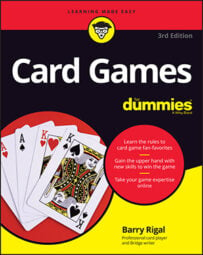Unfreezing the deck with the initial meld
The discard pile is automatically frozen for your side at the start of the game until your team makes its initial meld; that does not mean you can’t use it — but you can only use it under specific circumstances. Until the first meld comes, each player on the team can only take cards from the stock.Because the discard pile is frozen, you can’t use the top discard (and thus pick up the pile) unless you can use it on that turn in a meld with two cards of the same rank — in making that meld, no wild cards are allowed unless your combination already includes three natural cards.
After you or your partner makes the initial meld for your side, this restriction is lifted — but when either side discards a wild card, the pile freezes again for both sides. (See below for more details on this rule.)
Picking up the discard pile
You can pick up the top card from the discard pile to create or improve a meld. However, if you choose to take the top card, you must put down a meld immediately, using the discard in that meld.After you put down your meld, you take the entire discard pile and add it to your hand. You immediately grow a huge hand — if there were plenty of cards in the discard pile when you picked it up, of course. You also have the ability to make many melds and score points.
You can’t take that top discard unless you can make a meld with it or add it to an existing meld or Canasta — and sometimes not even then! (See the next section.)
After you pick up the discard pile, you can make any further melds you want. When you discard, your turn ends.After you or your partner makes the initial meld for the partnership, you can pick up the top card from the discard pile (and thus the whole pile) on your turn and put it down in a meld of three that includes a joker. Or you can pick up the pile if the top card matches one of your melds. But this only applies so long as the pile isn’t frozen (no wild cards are in the pile).
If you pick up the discard pile in error, either as a result of a miscalculation (the meld you envisioned isn’t high-scoring enough) or because you can’t make a legal meld with the card, you incur a 100-point penalty.
Freezing the discard pile
You can use wild cards (2s and jokers) for whatever card you want them to be. Wild cards are also stoppers — which means that you won’t normally be able to pick up a discarded wild card (and thus the pile as a whole) if the previous player lets go of one of them as a discard.If you throw a wild card away (normally an act of desperation), it freezes the discard pile — which makes it more difficult for subsequent players, including yourself and your partner, to pick up the discard pile. Freezing doesn’t make taking the discard pile impossible — just harder. If the pile is frozen, any subsequent player can only pick up the top card from the discard pile if she can use it to form a natural meld, using two cards of the same rank from her hand.
When you throw away a card that freezes the deck, be it permanently or temporarily, you place the card sideways to the rest of the deck.
The first player to make a natural meld (a meld with no wild cards) with a set that utilizes the top card of the discard pile “unfreezes” the discard pile, allowing her to pick up the discard pile.
When trying to prevent your opponents from taking the discard pile, throwing a black three is always safe. Wild cards are safe but come at a cost. Throw the cards that your opponent has not picked up before, or cards that you can see a lot of — either in your own melds or in your opponents’.

